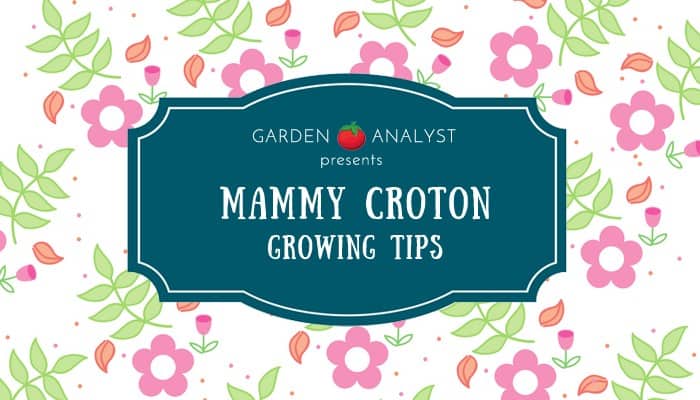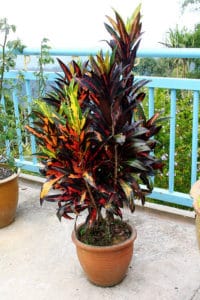Mammy Croton or Codiaeum variegatum ‘Mammy’ is a croton cultivar and a standard landscape plant in California and Florida. ‘Mammy’ croton is a brilliantly colored, small variety of crotons, vivid and colorful ornamental garden plants native to Australia, Malaysia, Indonesia and Pacific Islands. Learn more about a variety of crotons and how to care for them in this article.

Mammy Crotons plants are prized for their truly magnificent foliage with large, thick, leathery, and shiny leaves variegated with the various color shades such as orange, red, pink, yellow, green etc. This ornamental evergreen shrub will enhance both gardens and houses since it can be cultivated as an outdoor shrub and a houseplant too. The croton is a fairly easy plant to grow. Read the instructions bellow so you can get the best out of this beautiful and colorful plant.
Croton Varieties
There are several hundred of selected croton varieties and they come in a wide diversity of leaf shapes and colors. Depending on the cultivar, the leaves may have various shapes, variegated with pink, yellow, purple, orange etc. Even the color pattern can differ depending on the variety.
They feature many sizes – usual croton height is between 3 and 8 feet. There are many small shrubs that can be kept under 3 feet height, such as Mammy, one of the smallest crotons. It can be easily maintained about 2 to 2,5 feet high. Smaller varieties should be planted 2 feet apart, the larger varieties should be placed 2 to 3 feet apart.

Some of the popular varieties of crotons are America, Angel Wings, Andreanum, Angel Wings, Captain Kidd, Caribbean Star, Danny Boy, Dark Ruler, Eye, Franklin RooseveltIndian Rina, Irene Kingsley, Kentucky, Mona Lisa, Nestor, Punctatum, Red Rheedii, Sanderi, Shirley Temple, The Ramshorn, Tiger, Twist and Point, Undulatum, Vera, etc.
How To Care for Crotons
These slow-growing shrubs are easy-care and low-maintenance. Follow these instructions to keep crotons alive, healthy and brightly colored.
- Air temperature and humidity:
Crotons are native to warm climates, therefore are suitable for 9 -15 US hardiness zones. They can be grown outside only in regions where air temperature doesn’t normally drop bellow 50°F during the night and around 60°F during the daytime. They are usually grown as houseplants in colder climates.
Though the plant displays its best colors in cold weather, extremely cold or extremely hot locations don’t suit this plant. Temperature shifts and cold air can cause leaf loss. Crotons are not frost-resistant.
These plants also prefer to have a location with higher humidity, so make sure to provide them air humidity of 40-80%.
- Light:
The plenty of sun will enable the plant to keep its vibrant and bright colors. Place it in a sunny, bight place, perhaps in western or southern window location. But keep in mind that crotons should be shaded during the hottest part of the day since too much sun can bleach the color of their leaves.
- Soil and Fertilizing:
Crotons tolerate all types of soil: acidic, neutral or alkaline, but a well-drained soil is a must. You can fertilize the soil with a quality granular fertilizer 3 times a year – once each in spring, summer, and fall.
- Watering:
Water it regularly and don’t let the soil dry out. Though crotons like slightly moisture soil, they don’t like “wet feet”. Too much water can turn leaves brown on the edges.
- Pruning and trimming:
Trim it occasionally to control the plant’s size and achieve the desired shape. Do not cut the leaves, just cut the stems.
- Common issues:
The most common problems are spider mites, but they can be easily destroyed with a miticide.
How to Propagate Crotons
Propagation of crotons can be done in several ways, but the easiest ones are by stem cuttings and propagating in water.
- Stem Cuttings:
Cut a 5-6 inch long stem with at least 3 sets of leaves at the top. Cut just bellow a leaf joint. Remove all the bottom leaves, and dip the end of the cutting into a growing hormone. Place it in a moist soil (mix of sand and potting mix) and cover the container with a plastic bag to provide the cutting with moist and warm conditions. Open the bag regularly to check whether the plant needs water. You can propagate crotons by cuttings at any time of year and you’ll get a rooted croton within 4 weeks. When croton has developed its own root system, remove the plastic cover and place the plant in a shaded place for another 8-10 weeks. Remove it into a permanent container or plant it outside.
- Propagation in water:
Take a cutting 6 to 12 inch long and remove the bottom leaves. Put the leaf in a pot of water at about 68-77°F and keep it in shade until roots form.
Are Crotons Toxic?
Although the croton is a common houseplant, you should be very cautious handling it. The plant’s sap is highly toxic since it contains an oil with violently purgative and irritating qualities. It is even suspected that the oil is co-carcinogen.
All parts of the plant – leaves, stems, flowers and root – are poisonous if ingested. But an ingestion is usually not deadly. Some of the usual poisoning symptoms are nausea, vomiting, and diarrhea.
The contact with the plant’s sap can cause skin irritation and allergic reaction. Handling the plant can cause skin eczema in some people. Be sure to wear gloves while handling it.
Prevent children from touching the crotons since they have been fatally poisoned by toxic croton seeds. Maybe it’s best to avoid exotic, dangerous plants until children grow up.
The plant is also dangerous for pets such as dogs or cats. If your pet has eaten the croton, call a veterinarian or a poison control center immediately.
Buying Croton Plants Online
If you are unable to find Crotons at your local nursery, consider buying crotons online through the links below. This will help directly support Garden Analyst through an earning an affiliate commission that supports our work on the site